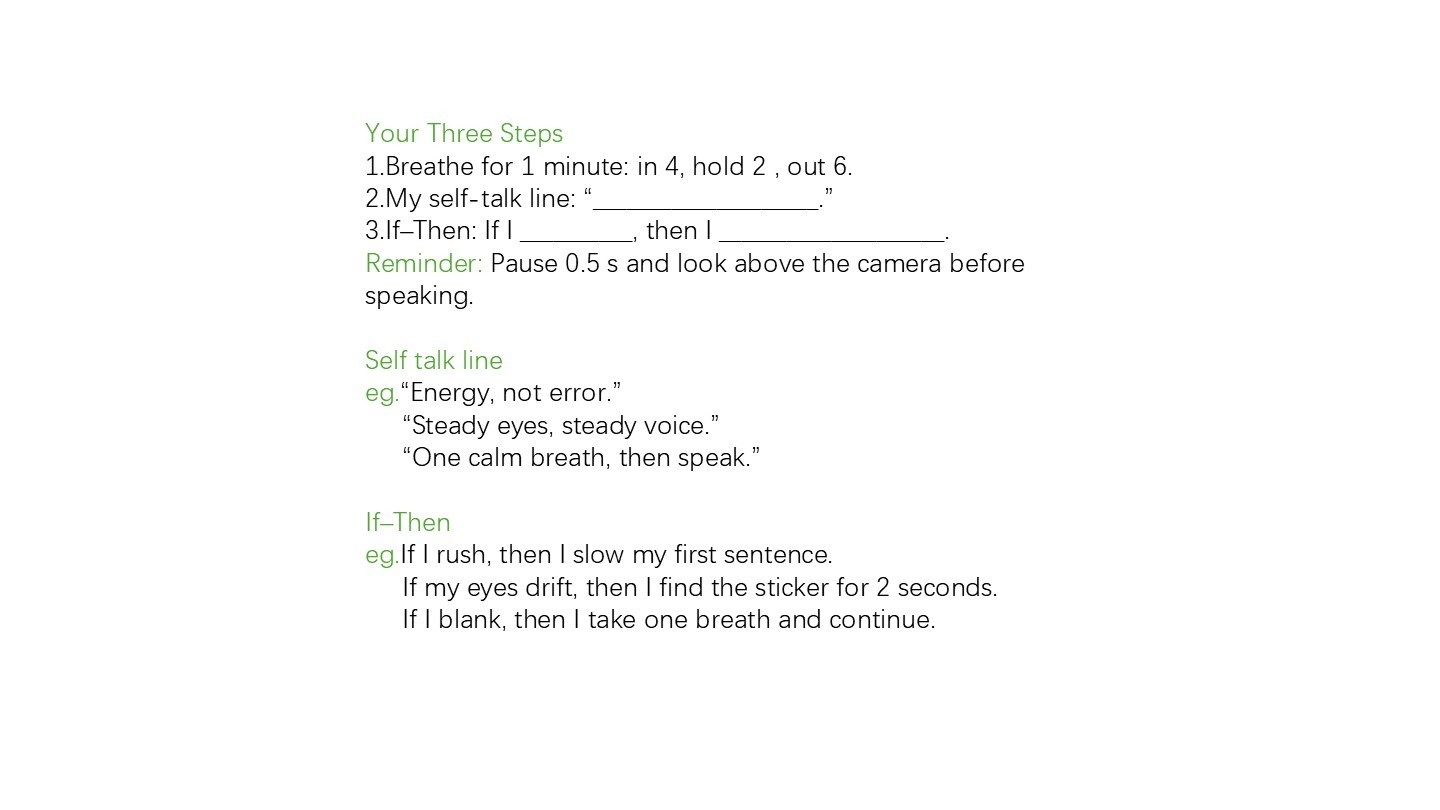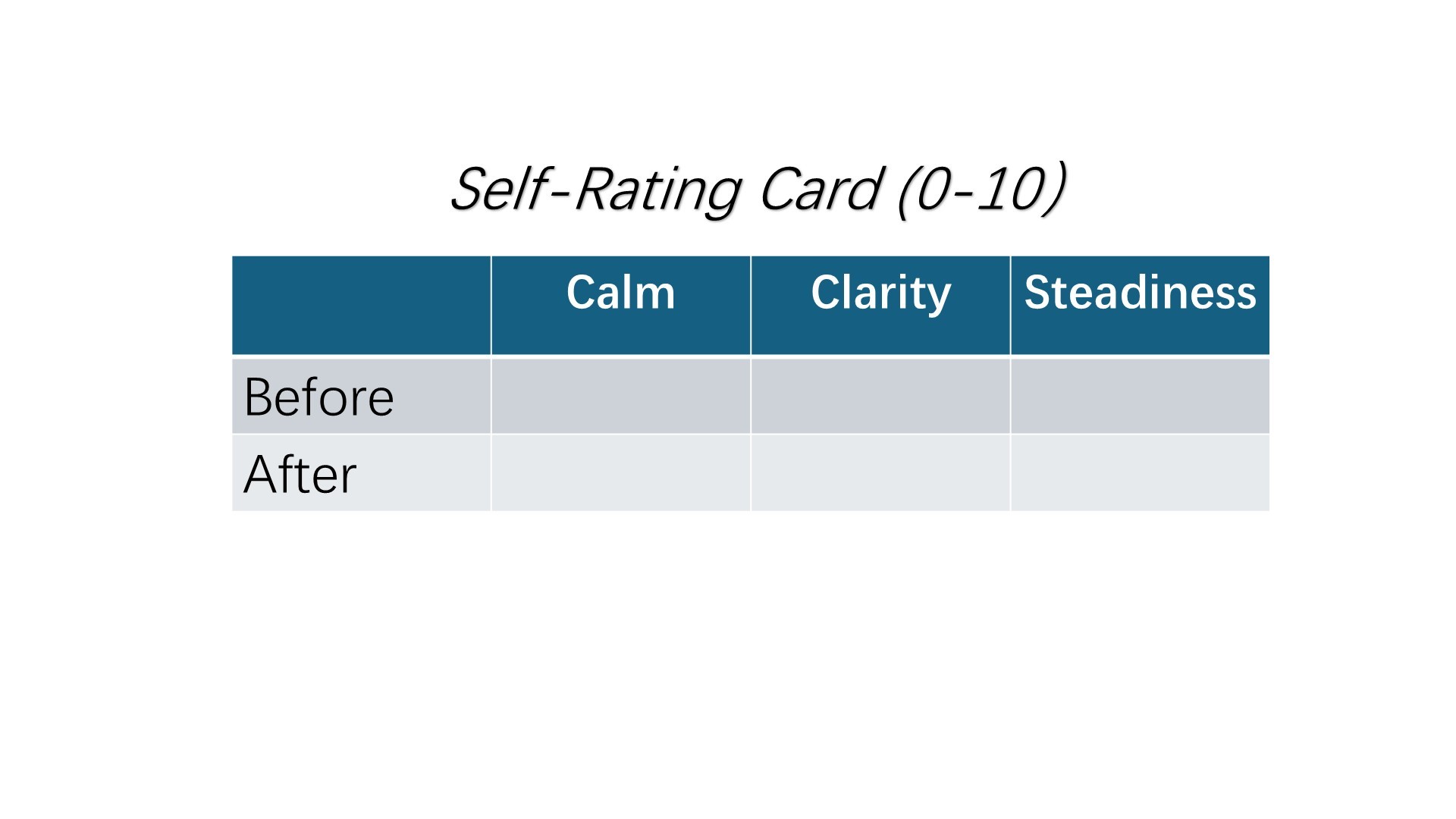From Nerves to Fuel (2025)

Summary
A 20-minute step-by-step OER to turn nerves into energy and deliver a clear 30-second opening on video or audio only.
Synopsis
A 20-minute, step-by-step toolkit that helps any learner turn nerves into energy and deliver a clear 30-second opening using paced breathing, a personal self-talk line, and an if-then plan.
How this toolkit connects
You will read for 30 seconds twice. The Practice Text Pack gives you short public-domain passages to read. The Mini Workbook gives you simple boxes to tick and space to note scores and file names.
What you need
A phone that can record video or audio; a small sticker 1–2 cm above the camera; a quiet corner and a timer.
You only need your phone and a quiet corner. If you want a record or a printable sheet, use the two files in Downloads (OER) at the end of this page.
How it works (3 keys)
1. Breathe with a 4-2-6 count for 1 minute
2. Say one personal self-talk line
3. Use one If–Then line, pause 0.5 s, look at the sticker, then speak
Look just above the camera, not at the screen. The small sticker is your eye target.

Eyeline Arrow (2025) by Yanan Wan, CC BY 4.0
Quick map
Pick one passage from the Practice Text Pack. Record a 30-second before clip. Do the one-minute calm routine. Record a 30-second after clip. Log your scores in the Mini Workbook. Aim for a one-point gain in calm or clarity or steadiness.
Steps (8)
1. Pick a passage. Open the Practice Text Pack. Choose Text A/B/C.
2. Set up. Put the phone at eye height. Place a small sticker 1–2 cm above the camera. Open your timer.
3. Record BEFORE (30 s). Read your chosen passage for 30 seconds. Save as before(video/mp4 or audio/m4a). Write the file name in the Mini Workbook.
4. Rate BEFORE. In the Mini Workbook, score Calm, Clarity, Steadiness (0–10).
5. Calm routine (≈1 min). Breathe in 4, hold 2, out 6 × 6. Tick the five or six boxes in the Mini Workbook. Write self-talk lines. Write one If–Then line.
6. Eyeline check. Tick sticker set and 0.5 s pause in the Mini Workbook. Look at the sticker, pause half a second, then start your first line.
7. Record AFTER (30 s). Read the same passage again. Save as after(video/mp4 or audio/m4a). Write the file name in the Mini Workbook.
8. Rate and reflect. Score Calm, Clarity, Steadiness again. Aim for +1 in any one score. Write two lines: what helped and what you will change next time.
These are the three keys you will use between the two recordings.

Three-Step Routine (2025) by Yanan Wan, CC BY 4.0.
Evaluate your learning
Use the quick rating for Calm / Clarity / Steadiness before and after. Aim for +1 point in any one measure.
Use the same three scores before and after. A small gain of +1 in any one measure counts as success.

Self-Rating Card (2025) by Yanan Wan, CC BY 4.0.
If you need a printable or you are teaching a group, download the files below. The Practice Text Pack provides the passages; the Mini Workbook lets you record file names and scores.
Downloads (OER)
• Mini Workbook (PDF) — CC BY 4.0 (mini-workbook-ccby)
• Practice Text Pack (PDF) — Public Domain (practice-texts-public-domain.pdf)
Access and ethics
Audio-only is fine. Keep files on your device. Share only with consent. No GenAI content is used.
Licence
© 2025 Yanan Wan. Licensed under Creative Commons Attribution 4.0 International (CC BY 4.0). Practice texts are Public Domain and credited.
Note: The site footer shows the platform’s default license. The files and images above are licensed as stated (CC BY 4.0 / Public Domain).


